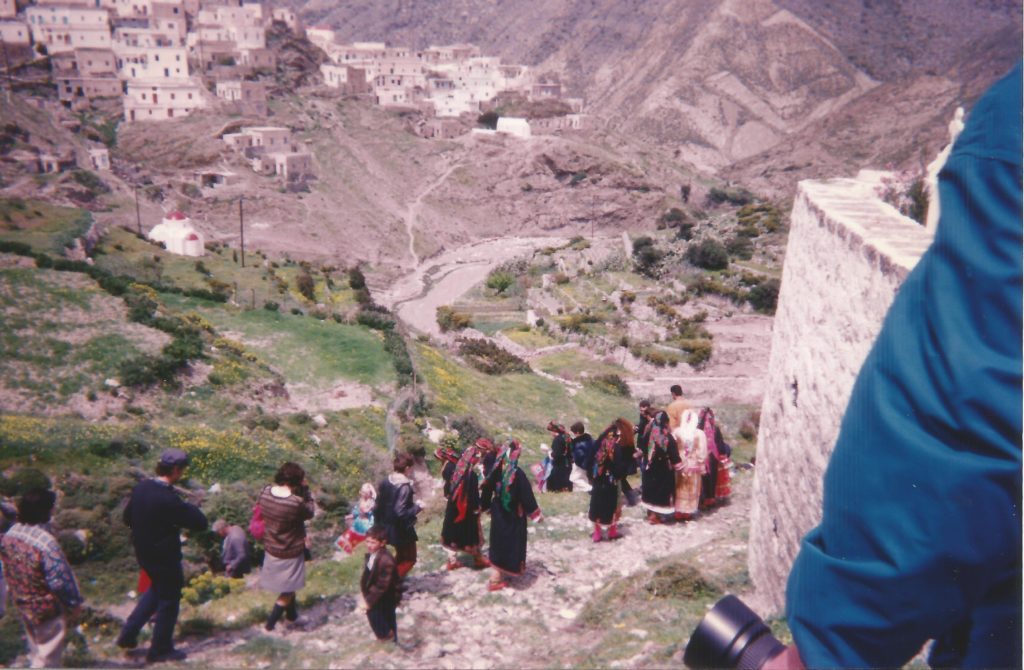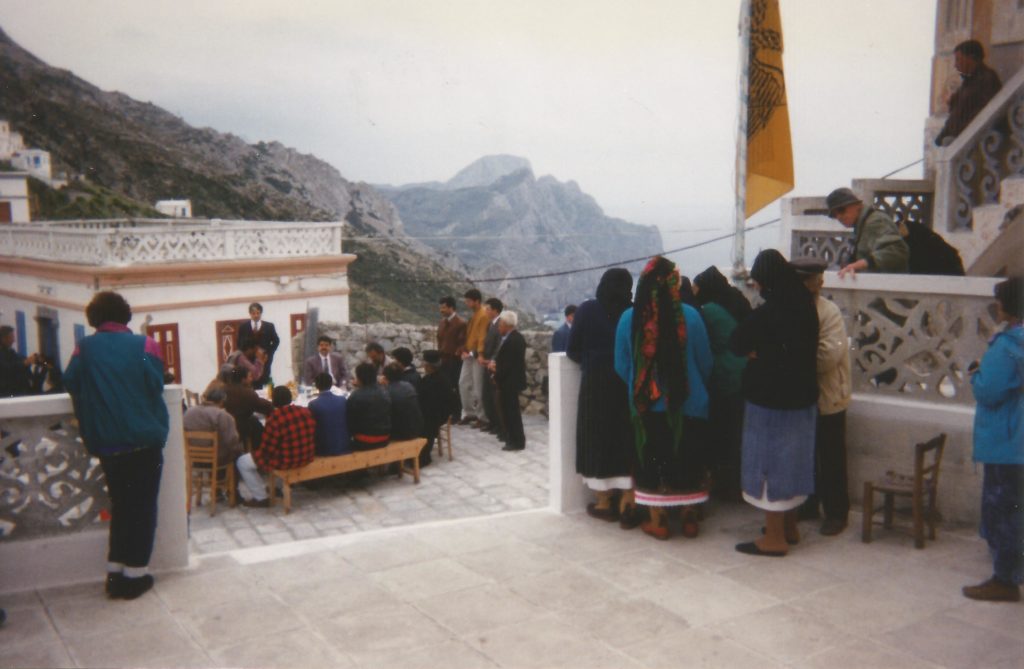Sat 9 Sep 2017
THE MOST BYZANTINE VILLAGE IN GREECE
Posted by belisarius under Byzantine Essays
[2] Comments
Some twenty years ago my wife and I visited the village of Olymbos on Karpathos in the Dodekanese islands. (Locally known as Elympos.) Our guidebooks had said that it was the most Byzantine of Greek villages and in fact preserved some medieval Greek and even Doric words not used elsewhere. At that time Olymbos or Olympos was still quite off the beaten path – the beaten path from the airport at the south end of the island being possibly the worst maintained road I’ve ever taken. I was happy that a cab driver convinced me not to rent a car. He likely saved our lives and was himself unwilling to drive it at night. The road – which had only been pushed through the rocky and mountainous countryside a decade or so before – was on the side of a cliff, largely unpaved, and it often washed away. There are Youtube videos of it and it seems not to have improved since. En-route to Olymbos our middle aged driver tells us that everyone (every male I presume) in the villages that we passed had worked in either Germany or the USA. At twenty-two his father had picked him a fourteen year old bride. Inheritance had passed through the first daughter on Karpathos, he told us, but today a father tries to provide a house for each girl child.
Olymbos is the female form of the Mt Olympos on which it is built. (There are quite a few peaks with that name.) It is thought to have been founded by refugees fleeing Saracen pirates who regularly attacked their villages in the 7th and 8th centuries. The mountainside is still lined with windmills, some of which still operate. Their horseshoe shape which resembles the towers of a fort was probably intended to deceive pirates. Not much is known about the specific history of the town or island during its Byzantine period but I was told by a local resident that the remains of four actual forts remain on Karpathos. That fact motivated me to write a never published short story about the people there preparing to fend off attackers intent on seizing their children as slaves, for indeed except for sheep there is little else of value on the stony mountains that form Karpathos.
This isolation for years kept the modern world from encroaching and even now the few hundred remaining residents keep alive their Byzantine era music, dances, and costuming – at least at festival times. Many Olympiaites now live in communities on Rhodes and Piraeus but visit their birthplace for festivals. We were there for a traditional Easter service and festival until the Tuesday after Easter when everyone including many ancient ladies seemingly effortlessly make their way along a steep and rocky path down to the cemetery where they distribute and share food – from home made cheeses to candy bars. A list of Olymbos festivals can be found at http://www.visitolympos.com/#xl_xr_page_index.
The Byzantine Emperor Nikephoros Phokas, after ejecting the Saracens who had occupied that part of the Dodekanese, formed the Thema of Crete which included Karpathos. Later it was governed by the Cretan-Venetian Kornaros family until 1537 when the Turkish navy overthrew “Frankish” rule. The distant Turkish rulers allowed the island a rare semi democratic self rule.
Of daily life on Olymbos Constantine Minos and Manolis Makris write that before the introduction of machine made shoes many men were shoemakers or blacksmiths. A unique hand made boot is still made and worn at Olymbos. “Nobody was idle in Olympos, apart from the sick. The living conditions and the environment enforced a certain lifestyle from the early age. Weak people could not live for long in Olympos. One had to have a very good face ‘from one night to the next’ which means from ‘from sunrise to sunset.’ The women were no exception. On the contrary, besides taking care of their children, the women had care of cooking as well, whereas Saturdays were baking and washing days. On Saturdays the men were also busy digging, cutting wood, bee keeping, or repairing their “stivania” (a kind of laced boots) or their tools. Only on Saturday evenings and Sunday mornings were the men free to go to the kafenio where they learnt the news and met other people. The husband and wife in Olympos were two inseparable partners working together against the difficult conditions in order to make a living for themselves and their many – six on average – children. If, on the other hand they were down on their luck, and they had to raise a loan, the man would put his field or house in pledge. If it were necessary to spend the wife’s sovereigns (gold British sterling coins), he would give her his house or field in return.“
Writing about local music and dance, Minos and Makris continue that even today “there are many traditional songs written in fifteen syllable lines calked sirmatika … The songs start very slowly. Somewhere in the middle of the song the beat becomes faster and becomes a crescendo towards the end. The songs are heroic, originating from the Byzantine era, ballads, some are historic songs, some talk about immigration … The exterpore martinades (couplets) are still flourishing.” Some praise and express their wishes to a newly wed couples, to the child who has just been christened… (and) to immigrants who have recently returned from abroad.
Much of this material and more can be found in an on-line article by Constantine Minos, Lecturer at the Aegean University. and his associate the writer Manolis Makris. I also recommend to the reader the photography of Julia Klimi, and quite a number of other photos and excellent videos also available on-line. Many of the videos are narrated in English but there are interviews with the islanders in German and Greek as well.
Vincent O’Reilly (aka: Paul Kastenellos)
apuleiusbooks.com


Good day very cool blog!! Man .. Beautiful .. Superb .. I’ll bookmark your web site and take the feeds additionally?
I’m happy to seek out so many helpful info here in the publish, we’d like work out extra
techniques on this regard, thanks for sharing. . .
. . .
Howdy very nice blog!! Man .. Beautiful .. Amazing .. I’ll bookmark your website and take the feeds also?
I’m happy to seek out so many helpful information right here within the publish, we want
work out more techniques in this regard, thank you for sharing.
. . . . .